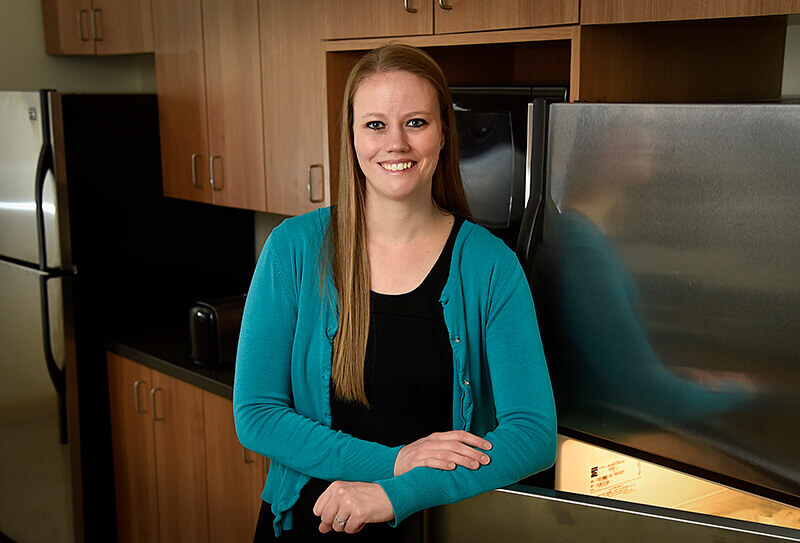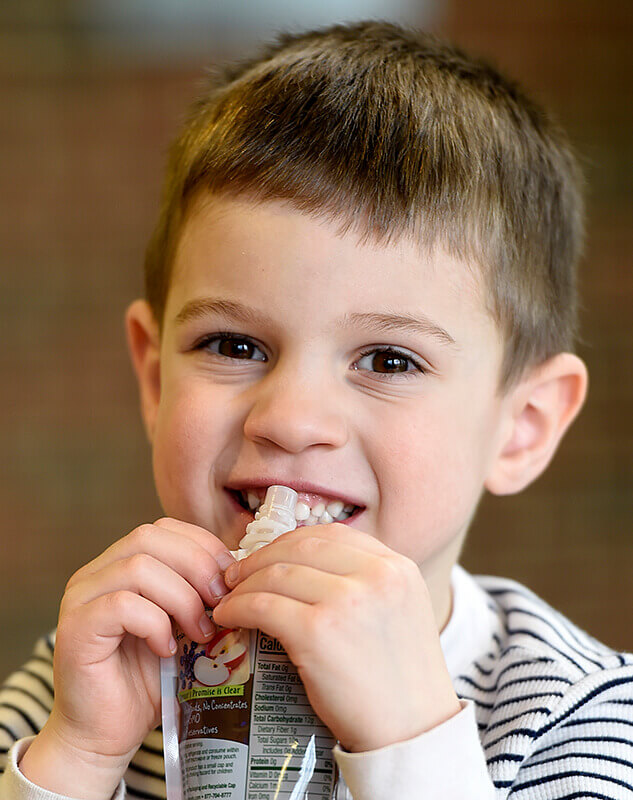March 31, 2020
Do pouches put the ‘squeeze’ on infant and toddler nutrition?
 Kameron Moding, an assistant professor of human development and family studies in Purdue’s College of Health and Human Sciences, looks at the nutrition values in toddler food pouches.
Download image
Kameron Moding, an assistant professor of human development and family studies in Purdue’s College of Health and Human Sciences, looks at the nutrition values in toddler food pouches.
Download image
WEST LAFAYETTE, Ind. — Squeezable food pouches for infants and toddlers are a popular item among parents as they are easy to use, transport and clean up.
But are they healthy for your kid? It all comes down to the main ingredients, says a Purdue University social scientist.
Kameron Moding is an assistant professor in the Department of Human Development and Family Studies in Purdue’s College of Health and Human Sciences, studies temperament, eating behaviors and obesity risk in early childhood. She researched ingredients and nutritional value in food pouches compared with jars and other containers while a postdoctoral researcher in The Children’s Eating Laboratory at the University of Colorado’s Anschutz Medical Campus.
 Squeezable food pouches are popular with toddlers and their parents. A Purdue University researcher looks at labels and nutritional values to see if what’s on the front of the pouch matches what is really on the inside. (Mark Simons/Purdue University photo)
Download image
Squeezable food pouches are popular with toddlers and their parents. A Purdue University researcher looks at labels and nutritional values to see if what’s on the front of the pouch matches what is really on the inside. (Mark Simons/Purdue University photo)
Download image
“Our research team found higher levels of sugars in infant/toddler food pouches compared to products in other packages,” she says. “This is likely due to the higher fruit contents of pouches compared to jars and packs. When we examined only products that contained fruit and vegetable blends, there were no differences in levels of sugars between pouches and other packages.”
The takeaway: Look, Moding says, at not only the label on the front of the package but also the ingredients list and the nutrition facts panel to determine the main ingredients.
Kale, spinach or other dark, leafy greens are lower in calories, rich in vitamins and good sources of folate and fiber. If fruit is one of the first ingredients, it likely contains more sugars, she says.
“The sweetness found in fruits can dim the bitterness found in some vegetables, like dark, leafy greens. Fruits likely increase the palatability of these products. At the same time, fruits also provide other beneficial nutrients, such as vitamin C, potassium, and various phytonutrients,” she says. “We encourage parents to to make sure that the nutrients and ingredients in the product match what they are hoping to buy for their child.”
About Purdue University
Purdue University is a top public research institution developing practical solutions to today’s toughest challenges. Ranked the No. 6 Most Innovative University in the United States by U.S. News & World Report, Purdue delivers world-changing research and out-of-this-world discovery. Committed to hands-on and online, real-world learning, Purdue offers a transformative education to all. Committed to affordability and accessibility, Purdue has frozen tuition and most fees at 2012-13 levels, enabling more students than ever to graduate debt-free. See how Purdue never stops in the persistent pursuit of the next giant leap at purdue.edu.
Writer: Matthew Oates, 765-496-2571, oatesw@purdue.edu, @mo_oates
Source: Kameron Moding, kmoding@purdue.edu, @KameronModing
Note to Journalists: A photograph of Kameron Moding and a child with a food pouch are available for journalists to use via a Google Drive. She is available for Skype and phone interviews.

